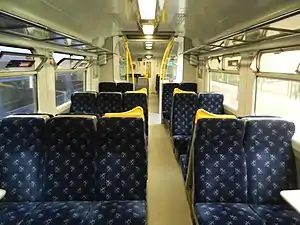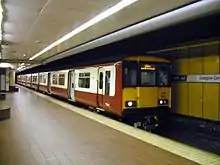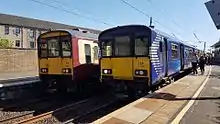British Rail Class 318
The British Rail Class 318 is an electric multiple unit (EMU) train, which operates in west central Scotland. The units were introduced on 29 September 1986 as part of the electrification of the Ayrshire Coast Line between Glasgow Central and Ayr/Ardrossan with alternating current (AC) overhead lines. Usage was extended to Largs in January 1987. They were also used on the Inverclyde Line in small numbers. The trains currently operate Argyle, Cathcart Circle Line, North Clyde Line and Inverclyde Line services. As of 2020, these are the oldest multiple units in Scotland, having been in revenue earning service for 34 years.
| British Rail Class 318 | |
|---|---|
 | |
 The interior of a ScotRail refurbished Class 318 | |
| In service | 1986–present |
| Manufacturer | BREL York |
| Family name | BR Second Generation (Mark 3) |
| Replaced | First Generation DMUs |
| Constructed | 1985–1986[1] |
| Refurbished | 2005–2007 Hunslet-Barclay, Kilmarnock 2013–2017 Wabtec, Doncaster |
| Number built | 21 trainsets |
| Formation | 3 cars per trainset |
| Fleet numbers | 318250–318270 |
| Operator(s) | Abellio ScotRail |
| Specifications | |
| Car length | DTSOL/DTSO: 19.83 m (65 ft 1 in) MSO: 19.92 m (65 ft 4 in)[1] |
| Width | 2.82 m (9 ft 3 in)[1] |
| Height | 3.70 m (12 ft 2 in)[1] |
| Doors | Double leaf sliding, pneumatically operated |
| Maximum speed | 90 mph (145 km/h)[2] |
| Weight | DTSOL: 30 t (29.5 long tons; 33.1 short tons) MSO: 50.9 t (50.1 long tons; 56.1 short tons) DTSO: 26.6 t (26.2 long tons; 29.3 short tons) total: 107.5 t (105.8 long tons; 118.5 short tons)[1] |
| Power output | 1,072 kW (1,438 hp)[1] |
| Acceleration | max. 0.56 m/s2 (2.0 km/(h⋅s); 1.3 mph/s)[2] |
| Electric system(s) | 25 kV 50 Hz AC Overhead |
| Current collection method | Stone Faiveley AMBR Pantograph |
| Braking system(s) | Disc |
| Track gauge | 1,435 mm (4 ft 8 1⁄2 in) standard gauge |
Background and history

.jpg.webp)
Effectively a 3-car version of the Class 317, 21 of these British Rail Mark 3-based units were built by BREL York works between 1985–1986 to replace the elderly Class 101, Class 107, Class 120 and Class 126 diesel multiple units (DMUs) which had worked the Glasgow South Western sector for nearly 30 years. The technical description of the units are DTSO+MSO+DTSO, consisting of a central motor car (with a roof mounted Stone Faiveley AMBR pantograph and four Brush TM2141 traction motors located under the floor within both bogies (two motors per bogie)) with a driving trailer at either end. The units run on the standard 25 kV AC overhead line system, and are standard class throughout.
The units have a maximum speed of 90 mph (145 km/h) and up to four sets can be worked in multiple to form a 12-car set, although platforms are only capable of handling 8-car trains. The 318 can also operate in multiple with the slightly newer Class 320 in a six car formation, which is regularly used on the North Clyde and Argyle Lines. Upon the introduction of the Class 334s onto Ayrshire/Inverclyde routes in 2001, both the 334 and 318 were found operating these lines together.
There were two named units: 318259 Citizens' Network and 318266 Strathclyder. Both have since been denamed
Accidents and incidents

In July 1995, units 318254 and 318262 were operating a Glasgow Central to Largs service when a braking system failure resulted in the train overshooting the end of the platform at Largs railway station. The train crashed through shops at the front of the station, and out into Main Street, Largs. Being very early in the morning, there were no serious injuries. The cab of vehicle 77244 (from set 318254) needed to be completely rebuilt, but 318262 managed to move by rail back to Shields depot. The reconstruction of the station building took almost ten years to complete.[3]
On 16 January 2008, unit 318267 was involved in a minor collision at Glasgow Central station. Class 334 unit 334017 was working the 08:24 passenger service from Gourock when it collided with the empty, stationary 318 whilst preparing to terminate at Glasgow Central. The 334 was in the process of braking and was travelling at less than 4 mph (6 km/h) when the collision occurred. Four passengers were slightly injured; however only one required hospital attention, and was transferred to Glasgow Southern General hospital in a taxi.[4]
Refurbishment
2005-2007 refurbishment


Between 2005 and 2007, all Class 318s underwent a conversion process which involved the removal of the corridor connection on the driver's cars.[5] Although this may seem detrimental to passengers, there have been no problems with the Class 334 or Class 320 units, which have no corridor connections. Besides improving the appearance of the driver's cars, it allows the driver to have a far more spacious working environment and gives them a better overall view.
The Class 318 units were refurbished at Hunslet-Barclay.[6] The passenger accommodation was also improved, with new passenger door controls,[5] a repainted interior and the installation of new grab handles.[5] New lighting was also fitted, with similar gondolas to the Class 320 units. First ScotRail originally promised new passenger information systems, similar to those seen on other trains.[5]
In September 2008 the Scottish Government's agency Transport Scotland announced that all ScotRail trains (including from the Strathclyde Partnership for Transport) would be eventually repainted in a new, blue livery with white Saltire markings on the carriage ends. Since the units had recently been refurbished and repainted, they would be the last in the EMU fleet to be repainted in Saltire livery. In the interim, all units had their "SPT Rail" naming removed, leaving them with an unbranded SPT livery.
2013-2017 refurbishment

The Class 318 units received a second refurbishment between October 2013 and October 2017.
The work included:
- Repainting into ScotRail saltire livery
- An internal refurbishment that included an internal repaint, new floor vinyl and new blue 'saltire' seat coverings.
- Fluorescent lights replaced with LED lighting.
- New floor-level lighting in the door vestibules.
- Small toilet replaced with a large accessible toilet, as recently fitted to the Class 320 fleet.
- Any corrosion repairs to bodywork
Unit 318251 headed south to Wabtec's Doncaster Works on 5 October 2013 and returned to Scotland on 28 March 2014.[7]
The refurbishment programme of the Class 318 fleet was completed in October 2017.
Fleet details
| Class | Operator | No. Built | Year Built | Cars per Set | Unit nos. |
|---|---|---|---|---|---|
| Class 318 | Abellio ScotRail | 21 | 1985-1986 | 3 | 318250 - 318270 |
References
- "Class 318". The Railway Centre. Archived from the original on 22 April 2019. Retrieved 19 June 2016.
- "Class 318". Eversholt Rail. Archived from the original on 22 April 2019. Retrieved 22 April 2019.
- March 2005 edition of First ScotRail's newsletter, firstInsight
- "Passengers hurt as trains collide". BBC Online. 16 January 2008. Archived from the original on 29 November 2020. Retrieved 19 April 2011.
- Class 318 Refurbishment Archived 8 July 2011 at the Wayback Machine - Brush Traction. Retrieved 20 March 2011.
- Class 318 Refurbishment Archived 30 December 2010 at the Wayback Machine - scot-rail.co.uk. Retrieved 14 February 2011.
- "scot-rail.co.uk » Class 318 Relivery Refurbishment 2013-2016". www.scot-rail.co.uk. Archived from the original on 20 October 2013. Retrieved 14 October 2013.
Further reading
| Wikimedia Commons has media related to British Rail Class 318. |